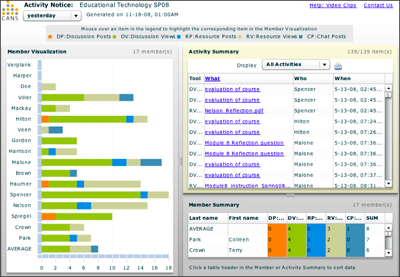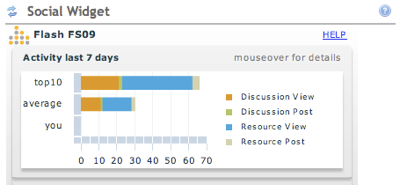
 FIPSE-CANS
FIPSE-CANS
FIPSE-CANS, led by Dr. James Laffey, is a design-based research project focused on developing the social navigation tool "Context-aware Activity Notification System" (CANS) for use in teaching and learning within the Sakai learning management system. CANS is a notification system which tracks users' activities within the learning system, stores those actions in a database, and then is able to provide reports to instructors and learners about that activity. The reports can be in the form of email, tables, or visualizations (such as bar graphs).
Design methodology
One of the basic premises for CANS is that by seeing what others are doing, it can help me (and others) to know what they should be doing. This is called social navigation.
Evaluation
By iterating CANS tools such as the visualizations and email digests, we can then run a study which seeks to understand how users are using the tools, if they benefit or perceive any benefit, and if so why...and if not, why that might be. With new design iterations, heavily qualitative formative evaluations and research occur. Surveys regarding social ability prior to the tools being implemented and afterwards, and at times if it's able, a comparison class. Most often, however, we evaluate how the tools are being used through in-depth successive interviews with the instructors and students in the classes which are employing the tools. After listening to the interviews, analyzing the data, we often identify some themes for moving forward in a better direction for the next iterations of the designs.
Iterations
 |

|
| First iteration of visualization tools: Individual social comparison, detailed information |
Later iteration of visualization tools: Generalized social comparison, less information |
The above iterations demonstrate what types of feedback we received in these examples. In the first iteration of the visualization tool, many students, even though they might enjoy looking at others, still felt like privacy was being invaded. This often made people feel uncomfortable, even though at times they found that information useful, especially when working in small collaborative groups. The later iteration, the "social widget", shows how the information was pared down (many people had mentioned there seemed to be an overload of data), it was small enough to go onto the front page (many never clicked to see it if it was hidden), and it generalized the social data so people were no longer identified.
